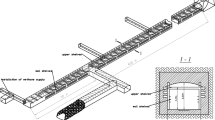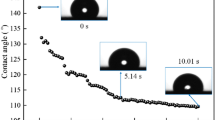Abstract
Experiments conducted with limestone dusts and dolomitic marble dusts have indicated that when rock dust is wetted and subsequently dried, it becomes a solid, non-dispersible cake. However, in order to be effectively inert a coal dust explosion, rock dust must be able to disperse as individual particles to air. To counteract this, rock dust manufacturers created treated rock dusts that will resist caking after moisture exposure. National Institute for Occupational Safety and Health (NIOSH) researchers conducted a series of laboratory-scale experiments on four base rock dusts and their treated counterparts to assess the effectiveness of various anti-caking additives after being exposed to moisture and then dried. The dusts were exposed to moisture using humidity cabinets having a high relative humidity (99% RH) and by also exposing the rock dust bed to water through bottom wicking. The dusts were then evaluated for dispersibility after drying using the NIOSH-designed dust dispersion chamber. The anti-caking additives were different concentrations of stearic acid, oleic acid, and xylene-based surfactants. All results were compared to a reference rock dust used to conduct large-scale experiments in the Lake Lynn Experimental Mine (LLEM), Fairchance, PA. When the untreated dusts were dried after exposure to moisture for 1 day, no dispersion was measured. However, rock dusts treated with anti-caking agents were readily dispersible even after exposure to moisture for 6 months. This report details the analysis and characterization of anti-caking additives using the NIOSH-designed dispersion chamber and the 20-L explosion test chamber.










Similar content being viewed by others
Notes
These were average RI values found in the Beckman Coulter manual for carbon and calcium carbonate and were not determined by a separate analysis.
References
Information Circular 9530 (2016). Review of Rock Dusting Practicing in Underground Coal Mines. By Harteis SP, Alexander DW, Harris ML, Sapko MJ, Weiss ES: U.S. Department of Health and Human Services, Centers for Disease Control and Prevention, National Institute for Occupational Safety and Health, DHHS (NIOSH) Publication No. 2010–151 p. 48
Cashdollar K and Hertzberg M (1989). Laboratory study of rock dust inerting requirements: effects of coal volatility, particle size, and methane addition. In: proceedings of the 23rd international conference of safety in mines research institutes, U.S. Department of the Interior, Bureau of Mines, Washington, September 11–15, 1989, 965–977
Christakis N, Wang J, Patel MK, Bradley MSA, Leaper MC, Cross M (2006) 'Aggregation and caking processes of granular materials: continuum model and simulation with application to sugar. Adv Powder Technol 17(5):543–565
Purutyan, H., G. I. Tardos and B. H. Pittenger (2005) ‘understanding and avoiding caking of bulk powders’, pp. 22-29, Chemical Engineering Progress (CEP)
Farber L, Tardos GI, Michaels JN (2003) Evolution and structure of drying material bridges of pharmaceutical excipients: studies on a microscope slide. Chem Eng Sci 58(19):4515–4525
Vogt E (2008) Hydrophobization of fine solids presented on the example of limestone powder. Pol J Chem Technol 10(1):49–51
Acme-Hardesty (2016). Calcium stearate, uses & applications. http://www.acme-hardesty.com/product/calcium-stearate/accessed 08/29/2016
Croda (2016). Priolen: Oleine. http://www.crodaindustrialchemicals.com/home
NOW (2016). Magnesium stearate FAQs. https://www.nowfoods.com/now/nowledge/magnesium-stearate-faqs
Sapko MJ, Weiss ES, Cashdollar KL, Zlochower IA (2000) Experimental mine and laboratory dust explosion research at NIOSH. J Loss Prev Process Ind 13:229–242
NIOSH (2010). Report of investigations 9679: recommendations for a new rock dusting standard to prevent coal dust explosions in intake airways. By Cashdollar KL, Sapko MJ, Weiss ES, Harris ML, man CK, Harteis SP, green GM: U.S. Department of Health and Human Services, Centers for Disease Control and Prevention, National Institute for Occupational Safety and Health, DHHS (NIOSH) publication no. 2010-151, p. 48
NIOSH (2011). Non-conforming rock dust. U.S. Department of Health and Human Services, Centers for Disease Control and Prevention, National Institute for Occupational Safety and Health, DHHS (NIOSH) publication no. HID 16, p. 4
Beckman Coulter (2011). Instruction for use, LS 13 320 laser diffraction particle size analyzer Beckman Coulter, PN B05577AB, October 2011, https://www.beckmancoulter.com/wsrportal/techdocs?docname=B05577AB.pdf
Perera IE, Sapko MJ, Harris ML, Zlochower IA (2016) Weiss ES [2016]. Design and development of a dust dispersion chamber to quantify the dispersibility of rock dust. J Loss Prev Process Ind 39:7–16
Cashdollar KL (1996) Coal dust explosibility. J Loss Prev Process Ind 9:65–76
Cashdollar KL (2000) Overview of dust explosibility characteristics. J Loss Prev Process Ind 13:183–199
Harris ML, Alexander D (2014) Moisture variance of mine dust samples and the inclusion of moisture as incombustible content. Min Eng 66(10):37–42
Harris ML, Sapko MJ, Zlochower IA, Perera IE, Weiss ES (2015) Particle size and surface area effects on Explosibility using a 20-L chamber. J Loss Prev Process Ind 37:33–38
Acknowledgments
The authors acknowledge NIOSH Pittsburgh Mining Research Division Physical Science Technicians, Linda Chasko, Jarod Myers, and James Addis for their support in conducting the laboratory work.
Author information
Authors and Affiliations
Corresponding author
Ethics declarations
Disclaimer
The findings and conclusions in this report are those of the authors and do not necessarily represent the views of the National Institute for Occupational Safety and Health (NIOSH). Mention of any company or product does not constitute endorsement by NIOSH.
Conflict of Interest
The authors declare that they have no conflict of interest.
Additional information
Publisher’s Note
Springer Nature remains neutral with regard to jurisdictional claims in published maps and institutional affiliations.
Rights and permissions
About this article
Cite this article
Perera, I.E., Harris, M.L. & Sapko, M.J. Analysis and Characterization of Anti-Caking Additives Used in Rock Dust to Mitigate Mine Explosions. Mining, Metallurgy & Exploration 38, 1411–1419 (2021). https://doi.org/10.1007/s42461-019-00142-3
Received:
Accepted:
Published:
Issue Date:
DOI: https://doi.org/10.1007/s42461-019-00142-3




